One day late for “Wordless Wednesday.”
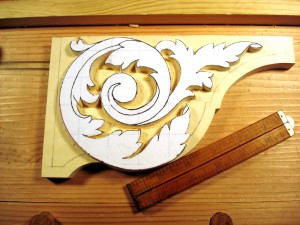
Chocolate powered woodworking
Some of the best things I’ve learned, whether in my computer geek career, building boats, or other activities, have been those lessons learned from making mistakes. In fact, I believe that becoming a “Master” in anything means accumulating more know-how about fixing mistakes than the basic know-how related to the skill, craft, trade, or profession. The master woodcarver isn’t the one who knows how to carve a beautiful Newport Shell, but the one who knows how to avoid the mistakes in carving that shell.
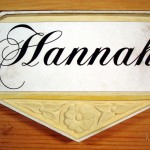 Simple carving patterns can be drawn directly onto the carving stock. For more complex patterns, or those requiring some degree of precision, I prefer attaching a paper pattern directly to the material. Transferring by carbon paper (they still make that stuff!?) or some similar method is tedious and error prone. Normally, rubber cement is my preferred bonding agent. Patterns are easy to reproduce on the computer, and to print when needed. I attach one to a block of wood and cut through it. When it is no longer needed, the remnants are easily peeled off and the cement residue rubbed away.
Simple carving patterns can be drawn directly onto the carving stock. For more complex patterns, or those requiring some degree of precision, I prefer attaching a paper pattern directly to the material. Transferring by carbon paper (they still make that stuff!?) or some similar method is tedious and error prone. Normally, rubber cement is my preferred bonding agent. Patterns are easy to reproduce on the computer, and to print when needed. I attach one to a block of wood and cut through it. When it is no longer needed, the remnants are easily peeled off and the cement residue rubbed away.
At the start of the recent carving projects, my can of rubber cement was empty. I tried a couple of substitutes. A pattern was attached to one block with liquid hide glue, and to another with yellow glue.
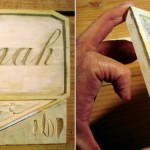 BIG MISTAKE! Both glues led to the same problem. Moisture dissolved ink from the patterns, letting it wick into the carving’s surface. OUCH! It was OK on the Markus carving because the top surface of all the fish was carved away anyway, and the tops of the letters could be sanded clean (hate sanding!). It was disastrous with the Hannah carving (yellow glue), leaving a dark smear across the finished surface, with leaching too deep to sand away. The problem was discovered after the last step of that carving, the lettering. So, it needed a complete “do over.” The Georg pattern has a lot of ink in it, and not too far into that carving, I removed the pattern by (erroneously) softening the hide glue with water. ARRGH!
BIG MISTAKE! Both glues led to the same problem. Moisture dissolved ink from the patterns, letting it wick into the carving’s surface. OUCH! It was OK on the Markus carving because the top surface of all the fish was carved away anyway, and the tops of the letters could be sanded clean (hate sanding!). It was disastrous with the Hannah carving (yellow glue), leaving a dark smear across the finished surface, with leaching too deep to sand away. The problem was discovered after the last step of that carving, the lettering. So, it needed a complete “do over.” The Georg pattern has a lot of ink in it, and not too far into that carving, I removed the pattern by (erroneously) softening the hide glue with water. ARRGH!
Lesson: For patterns that are to be bonded to the carving material, test to see if the bonding agents (or removal agents) will leave undesirable stains. I have a new can of rubber cement. … and am now a slightly wiser carver.
Our grandchildren now have name signs to mark their territory. Each is about 7 inches wide by 5 inches high. They are carved from basswood. Running in order of age, oldest first, we have… (click on images for larger views)
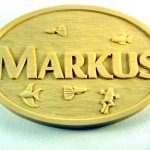 Markus – Master of the aquarium. He keeps many colorful varieties well fed and healthy.
Markus – Master of the aquarium. He keeps many colorful varieties well fed and healthy.
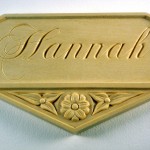 Hannah – Quiet, thinking, studious. The floral motif on her carving is taken from the philosopher’s carving on Giotto’s campanile in Florence.
Hannah – Quiet, thinking, studious. The floral motif on her carving is taken from the philosopher’s carving on Giotto’s campanile in Florence.
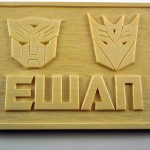 Ewan – Transformers, Transformers, Transformers. He has a large collection and knows how to transform each of them.
Ewan – Transformers, Transformers, Transformers. He has a large collection and knows how to transform each of them.
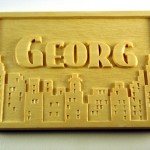 Georg – The builder. He’s always building interesting structures from Lego or from wood blocks. Often, he builds to great heights.
Georg – The builder. He’s always building interesting structures from Lego or from wood blocks. Often, he builds to great heights.